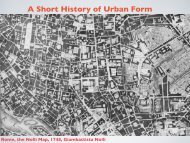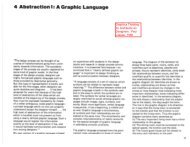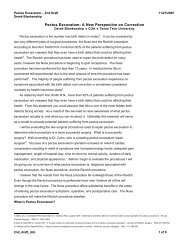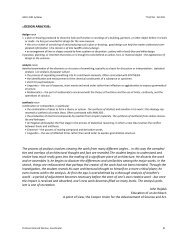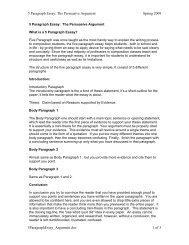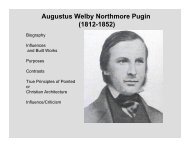The Eyes of the Skin
The Eyes of the Skin
The Eyes of the Skin
Create successful ePaper yourself
Turn your PDF publications into a flip-book with our unique Google optimized e-Paper software.
50Adrian Stokes, <strong>the</strong> English painter and essayist, makes perceptiveobservations about <strong>the</strong> interaction'Like mo<strong>the</strong>rs<strong>of</strong> space and sound, sound and stone.<strong>of</strong> men, <strong>the</strong> buildings are good listeners. Long sounds,distinct or seemingly in bundles, appease <strong>the</strong> orifices <strong>of</strong> palaces that leanback gradually from canal or pavement. A long sound with its echobrings consummationto <strong>the</strong> stone,' he writes.10.J-Anyone who has half-woken up to <strong>the</strong> sound <strong>of</strong> a train or an ambulancein a nocturnal city, and through his/her sleep experienced <strong>the</strong>space <strong>of</strong> <strong>the</strong> city with its countless inhabitantsscattered within its structures,knows <strong>the</strong> power <strong>of</strong> sound over <strong>the</strong> imagination;sound is a reminder<strong>the</strong> nocturnal<strong>of</strong> human solitude and mortality, and it makes oneconscious <strong>of</strong> <strong>the</strong> entire slumbering city. Anyone who has becomeentrancedby <strong>the</strong> sound <strong>of</strong> dripping water in <strong>the</strong> darkness <strong>of</strong> a ruin canattest to <strong>the</strong> extraordinarycapacity <strong>of</strong> <strong>the</strong> ear to carve a volume into <strong>the</strong>void <strong>of</strong> darkness. <strong>The</strong> space traced by <strong>the</strong> ear in <strong>the</strong> darkness becomes acavity sculpted directly in <strong>the</strong> interior <strong>of</strong> <strong>the</strong> mind.<strong>The</strong> last chapter <strong>of</strong> Steen Eiler Rasmussen's seminal book ExperiencingArchitecture is significantly entitled 'Hearing Architecture'. 105 <strong>The</strong> writerdescribes various dimensions <strong>of</strong> acoustical qualities, and recalls <strong>the</strong>acoustic percept <strong>of</strong> <strong>the</strong> undergroundtunnels in Vienna in Orson Welles'film <strong>The</strong> Third lv/an: 'Your ear receives <strong>the</strong> impact <strong>of</strong> both <strong>the</strong> length and<strong>the</strong> cylindrical form <strong>of</strong> <strong>the</strong> tunnel.' lOGOne can also recall <strong>the</strong> acoustic harshness <strong>of</strong> an uninhabited andunfurnished house as compared to <strong>the</strong> affability <strong>of</strong> a lived home, inwhich sound is refracted and s<strong>of</strong>tened by <strong>the</strong> numerous surfaces <strong>of</strong>objects <strong>of</strong> personalsound <strong>of</strong> intimacy or monumentality,life. Every building or space has its characteristicinvitation or rejection, hospitalityor hostility. A space is understood and appreciated through its echo asmuch as through its visual shape, but <strong>the</strong> acoustic percept usually remainsas an unconscious background experience.Sight is <strong>the</strong> sense <strong>of</strong> <strong>the</strong> solitary observel~ whereas hearing creates asense <strong>of</strong> connection and solidarity; our look wanders lonesomely in <strong>the</strong>THE EYES OFTHE SKINdark depths <strong>of</strong> a ca<strong>the</strong>dral, but <strong>the</strong> sound <strong>of</strong> <strong>the</strong> organ makes us immediatelyexperience our affinity with <strong>the</strong> space. 'vVestare alone at <strong>the</strong> suspense<strong>of</strong> a circus, but <strong>the</strong> burst <strong>of</strong> applause after <strong>the</strong> relaxation <strong>of</strong> suspense unitesus with <strong>the</strong> crowd. <strong>The</strong> sound <strong>of</strong> church bells echoing through <strong>the</strong> streets<strong>of</strong> a town makes us aware <strong>of</strong> our citizenship. <strong>The</strong> echo <strong>of</strong> steps on apaved street has an emotional charge because <strong>the</strong> sound reverberatingfrom surrounding walls puts us in direct interaction with space; <strong>the</strong> soundmeasures space and makes its scale comprehensible. We stroke <strong>the</strong>boundaries<strong>of</strong> <strong>the</strong> space with our ears. <strong>The</strong> cries <strong>of</strong> seagulls in <strong>the</strong> harbourawaken an awareness <strong>of</strong> <strong>the</strong> vastness <strong>of</strong> <strong>the</strong> ocean and <strong>the</strong> infiniteness<strong>of</strong> <strong>the</strong> horizon.Every city has its echo which depends on <strong>the</strong> pattern and scale <strong>of</strong> itsstreets and <strong>the</strong> prevailing architectural styles and materials. <strong>The</strong> echo <strong>of</strong>a Renaissance city differs from that <strong>of</strong> a Baroque city. But our cities havelost <strong>the</strong>ir echo altoge<strong>the</strong>r. <strong>The</strong> wide, open spaces <strong>of</strong> contemporarystreetsdo not return sound, and in <strong>the</strong> interiors <strong>of</strong> today's buildings echoes areabsorbed and censored. <strong>The</strong> programmed recorded music <strong>of</strong> shoppingmalls and public spaces eliminates <strong>the</strong> possibility <strong>of</strong> grasping <strong>the</strong> acousticvolume <strong>of</strong> space. Our ears have been blinded.Silence, Time and Solitude<strong>The</strong> most essential auditory experience created by architecture is tranquillity.Architecture presents <strong>the</strong> drama <strong>of</strong> construction silenced intomatter, space and light. Ultimately, architecture is <strong>the</strong> art <strong>of</strong> petrifiedsilence. 'vVhen <strong>the</strong> clutter <strong>of</strong> construction work ceases, and <strong>the</strong> shouting<strong>of</strong> workers dies away, a building becomes a museum <strong>of</strong> a waiting, patientsilence. In Egyptian temples we encounter <strong>the</strong> silence that surrounded<strong>the</strong> pharaohs, in <strong>the</strong> silence <strong>of</strong> <strong>the</strong> Gothic ca<strong>the</strong>dral we are reminded <strong>of</strong><strong>the</strong> last dying note <strong>of</strong> a Gregorian chant, and <strong>the</strong> echo <strong>of</strong> Roman footstepshas just faded away from <strong>the</strong> walls <strong>of</strong> <strong>the</strong> Pan<strong>the</strong>on. Old houses takeus back to <strong>the</strong> slow time and silence <strong>of</strong> <strong>the</strong> past. <strong>The</strong> silence <strong>of</strong> architec-PART 2 51




